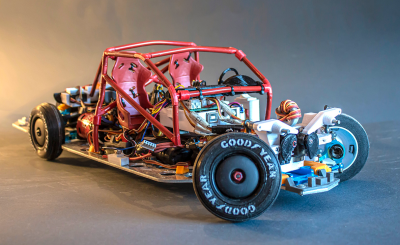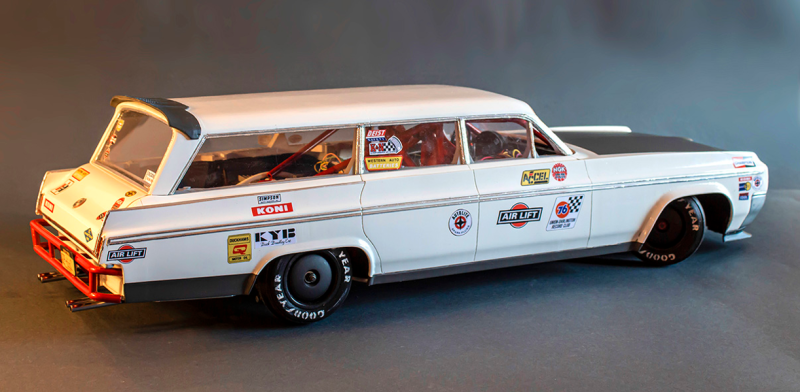When you’re a kid, remote control cars are totally awesome. Even if you can’t go anywhere by yourself, it’s much easier to imagine a nice getaway from the daily grind of elementary school if you have some wheels. And yeah, R/C cars are still awesome once you’re an adult, but actual car-driving experience will probably make you yearn for more realism.
What could be more realistic and fun than an active suspension? Plenty of adults will never get the chance to hit the switches in real car, but after a year of hard work, [snoopybg] is ready to go front and back, side to side, and even drift in this super scale ’63 Oldsmobile Dynamic 88 wagon. We think you’ll agree that [snoopybg] didn’t miss a detail — this thing makes engine noises, and there are LEDs in the dual exhaust pipes to simulate flames.
 An Arduino reads data from a triple-axis accelerometer in real time, and adjusts a servo on each wheel accordingly, also in real time, to mimic a real car throwing its weight around on a real suspension system. If that weren’t cool enough, most of the car is printed, including the tires. [snoopybg] started with a drift car chassis, but even that has been hacked and drilled out as needed.
An Arduino reads data from a triple-axis accelerometer in real time, and adjusts a servo on each wheel accordingly, also in real time, to mimic a real car throwing its weight around on a real suspension system. If that weren’t cool enough, most of the car is printed, including the tires. [snoopybg] started with a drift car chassis, but even that has been hacked and drilled out as needed.
There are a ton of nice pictures on [snoopybg]’s site if you want to see what’s under the hood. We don’t see the code anywhere, but [snoopybg] seems quite open to publishing more details if there is interest out there. Strap yourself in and hold on tight, because we’re gonna take this baby for a spin after the break.
If this is all seems a bit much for you, but you’ve got that R/C itch again, there’s a lot to be said for upgrading the electronics in a stock R/C car.
Via r/duino















That looks very realistic. Great modeling for movies!!!
That is probably the most realistic RC car I’ve ever seen. The body roll and weight shift are so good! I think this will be the next Big Thing in scale RC cars at this rate.
Cool
My initial reaction was “what’s the point???!?!” but then I watched the video and now think it’s the most awesome RC car I’ve ever seen. Really funny, clever and nicely done!
Very nice! Looks so natural. Servo noise is a bit unfortunate though.
First off, it’s an Olds baby, an Olds. I applaud the car choose, you dont see enough Olds out there. Secound this is awesome, I mean it just looks great. Great job. Now do this with a red 58 Plymouth fury and have one cool rc car
1974 Dodge Monaco sedan…we need an RC Bluesmobile.
“…you dont see enough Olds out there.”
Casualty of the badge-engineering wars. Go look at the brownfields in place of their Lansing, MI operation on Google Earth. (I grew up nearby) Destroyed the local economy.
The movement is fantastic, but so it the look of that shell. They said it’s printed with a vinyl wrap stretched over it. That process deserves a HaD post on its own.
This is completely awesome. Brilliant idea and supremely implemented. I watched it the first time without sound so missed the servo noise, but the effect is intense. The only thing I noticed is that the side to side roll is just a tad delayed. Other than that one imperfection, this is just an unreal project and perfect for HaD.
It seems the micro-servos might be a little underpowered and they’re geared down by a cam-follower mechanism that slows them down. He said that if he’d gone for bigger servos, he would have them linked directly to the suspension. (However, that’d make the opposite problem: short travel is fast but low resolution and jerky)
The servos are controlled by an Arduino, which might also limit the speed depending on how the software library is generating the signals. Whether the update frequency is low or high (10 – 70 Hz), it affects the effective internal duty cycle of the servo and makes it stronger or weaker. The nominal frequency should be 40 Hz but it’s difficult to tell at a quick glance what they’re doing with it and how the servo channels are interleaved to the timers.
Besides, if you have an update rate of 40 Hz then the fastest vibration you can produce is 20 Hz which in itself produces the appearance of a puppet animation. If you bump the servo signal frequency to 72 Hz then the system bandwidth grows to 36 Hz and it looks a lot smoother – but this requires writing custom code to handle the signal generation.
It’s not hard, just tedious to figure it out.
Best model car ever for petrolheads, but German TÜV would say: “Needs new shock absorbers” ;-)
Quite amazing, even the sound generator alone is way better than what I’ve seen on other RC cars.
This is brilliant, very cool project!
Clubs here are quite active and do a good amount RC Car racing. Was very handy for a father/son social activity and hobby. Helped “build a kid”. Heh… he thought I was working on the cars…
Clue for you. The entire hobby was a money war. Dad with the biggest wallet had the kids that would win.
We had a fine time. Excellent social activity for the kids.
I’ve not done that kind of modelling. Would it have been significantly more difficult to make an accurate suspension system and vehicle weight which would have rolled and bounced like that without emulating it?
Only if you want to film it at 10x speed and slow it down. There’s a lot of moments and levers involved, which as you’ll remember from high school physics work on pendulums have an oscillatory period related to length, not weight.
Perhaps I poorly worded my previous comment, the accuracy I meant was from a kinematic point of view rather than accurately modelling the structure of the original vehicle.
Otherwise if the only thing that affected the speed of an oscillator was the length of the lever I would agree absolutely, but springs, gears and damping systems do exist.
I’m sure it *could* be done mechanically, but it would be much more complex, difficult and need to be highly tuned to produce the same scale effect. It would almost certainly require custom springs and probably a suspension held in both compression and tension, and then a tuned damping system. And then the system is tuned specifically and only for *that* chassis and weight.
Using servos and sensors lets you have one system and then tune it for any scale effect simply by updating the program. So yea, it definitely would have been more difficult and limiting to achieve the same effect mechanically.
Yeah, I tried to think of how it would look, but I don’t even know how the suspension of such a weirdly bouncy real car would look to make it roll around so much. American cars were really solving a different problem when they looked like this.
The thing is, rotational inertia and mass don’t scale the same with linear dimensions, so you’ll have real troubles getting the suspension tuned right. You have to add extra mass to have the same body roll, but that extra mass pushes the suspension down and requires stiffer springs to hold it up, which then reduces the body roll.
You’d have to device some sort of critically balanced unstable suspension that holds the mass up but does not itself contribute to the stiffness of the suspension, and then add other springs to emulate the real suspension.
I don’t think you’d be able to get the appropriate frequencies to make it look right. Even if you increased the weight substantially, it’s still not going to jounce like a 4000 lb car. The inertia of a platform this small just doesn’t lend itself to large scale movements.
Needs a Ghostbuster logo.
Now for a pneumatic suspension model…
I’ll just leave this here, because..
https://youtu.be/hg_KZQ7k3kI
This looks like an “Industrial Light and Magic” Model Shop Résumé. Awesome work. Hours well spent.
Imagine that.